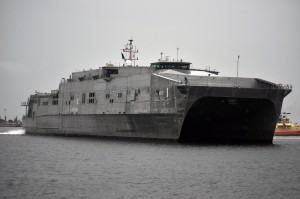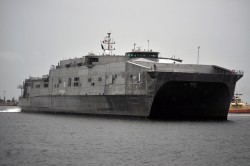This article is part of our “Sacred Cows Week.”
As articles and blog posts often point out, US naval forces have been largely unchallenged at sea since World War II. Today we face the largest danger since 1945, in the form of severe budgetary cutbacks and fiscal austerity that affect our manning and readiness. After nonnegotiable items like paychecks and food supplies, there is little leftover for R&D, systems upgrades, or the planned expansion to 300 vessels in the next decade.
We face a paradox: while the Navy’s budget is downsizing, its mission requirements are expanding. With the rebalance to the Pacific, there is a lot of ocean that the Navy has to cover—64 million square miles in fact. Our forces are occupied daily from maintaining ballistic missile defense off the coast of North Korea to aiding efforts in Japan after the nuclear disaster at Fukushima to monitoring territorial disputes in the East China Sea to conducting counter-piracy operations among the Indonesian archipelagos. In the words of Admiral Greenert, Chief of Naval Operations, “Presence is our mandate. We have to be where it matters. We need to be there when it matters. And we need to be ready when it matters.” How can we be there, from the Strait of Malacca to the Second Thomas Shoal, when we’re $14 billion dollars short?
It requires the reversal of an adage, a sacred value we pride ourselves on and indeed have executed expertly: “Quality over Quantity!” If we are to achieve Forward Presence and Power Projection, we must instead turn to the new values of “Quantity and Distribution.” We are accustomed to having the highest quality maritime assets on the seas. But in the current times, and for the foreseeable future, the US Navy cannot finance these types of assets in the quantity necessary to maintain a presence across the world’s oceans.
Instead we need smaller and simpler vessels that are relatively inexpensive to produce and maintain. What they sacrifice in capability, such ships gain in speed and affordability—speed to respond quickly, affordability to be mass-distributed. Such a fleet would promote regional stability and establish a forward US Navy presence everywhere they are deployed. If a situation requires bigger guns, the Navy’s more capable (and accordingly more expensive) assets can be dispatched as backup. Smaller ships also offer the advantage of reducing vulnerability. Expensive gray-hulls are single high value targets compared to a dispersed group of low-cost vessels.
 What platform would fill this role exactly? Perhaps a new program is needed, or perhaps an existing program can be adapted such as the Littoral Combat Ship (LCS) or the Joint High Speed Vessel (JHSV). One thing is for sure, it won’t be the DDG1000 or the Gerald R. Ford aircraft carrier. The Mobile Landing Platform (MLP) and its variant, the Afloat Forward Staging Base (AFSB), are promising programs. John Glenn, the second in this line produced by General Dynamics, was just floated in San Diego this past September. Essentially a modified oil tanker, these 840-foot vessels offer a plethora of storage space, a large open deck, and ballast tanks capable of flooding parts of the deck to take on hovercraft. MLPs may not be the quality of technological superiority that we are used to; but at a mere $500 million a copy, they bring capability for a price at which we can afford the quantity.
What platform would fill this role exactly? Perhaps a new program is needed, or perhaps an existing program can be adapted such as the Littoral Combat Ship (LCS) or the Joint High Speed Vessel (JHSV). One thing is for sure, it won’t be the DDG1000 or the Gerald R. Ford aircraft carrier. The Mobile Landing Platform (MLP) and its variant, the Afloat Forward Staging Base (AFSB), are promising programs. John Glenn, the second in this line produced by General Dynamics, was just floated in San Diego this past September. Essentially a modified oil tanker, these 840-foot vessels offer a plethora of storage space, a large open deck, and ballast tanks capable of flooding parts of the deck to take on hovercraft. MLPs may not be the quality of technological superiority that we are used to; but at a mere $500 million a copy, they bring capability for a price at which we can afford the quantity.
As the US continues to shift from large-scale conventional wars to geographically diverse low-intensity conflicts, the Navy’s forces must be tailored with the current financial hardships in mind. With changing times come changing values, and it is finally time to shelf the demand for quality and instead favor quantity.
References:


I liked your article – however, I have a slightly different perspective on the concept of quantity over quality I’d like to offer. Perhaps it is seen as quantity that the CNO is trying to field but I believe that with consideration to the US getting it’s fiscal house in order, Navy is offering a solution that changes the mix of capabilities fielded in the form of type/model/series. This solution is definitely far less capable than what could be put forward with appropriate resources- but now is not the time to offer those solutions.
So I offer that the US Navy is attempting to provide a balanced approach of being forward…to achieve strategic objectives with risk…risk that high end combatant forces will not be required in particular AORs. This strategy does reduce the US Navy’s ability to swing credible combat forces to certain crisis. But I’m willing to bet that the US believes certain crisis will not occur for a period of time. Thus the risk is acceptable but still leaves an unsettling feeling.
In the end the Navy will always produce the best quality products – they may just have reduced capability from what has been fielded in the past.
Good post! You should also check out the small vs big ship force structure debate involving CDR Pournelle on Info Dissemination, ADM Harvey (and others) in Proceedings (“Flotilla Navy”) and ‘Lazarus’, also Info Dissemination and here.
My only quibble is your opening line “US naval forces have been largely unchallenged at sea since World War II.” If today the U.S. is facing the challenge of the PLA(N) and regional cooperation in the Pacific, did not the U.S. in the Cold War face the challenge of the Soviet Navy across several global theaters?
Mike,
Well put. I think we should send all of the Naval Academy’s YP’s overseas to act as patrol craft. They are small. Admittedly they do lack in speed but we can get them for cheap.
-Renaissance Man
There is potential. Perhaps we should discuss at our next i2 roast…
The USN preference for quality over quantity goes back to the apparent success of the 44 gun frigates in the War of 1812, except that we may have gotten the wrong message. Actually the British won the naval war, with their individually inferior, but vastly more numerous frigates and smaller cruisers, wiping out our trade and bottling up our fleet.
In WWII, it was the Japanese who placed greatest emphasis on quality vice quantity, while the US employed a high-low mix. We know how that turned out. Of course, industrial potential played a big part, but looking at the relative strength of China’s ship building industry, there may be a lesson there too.
If we must accept quantity over quality then one solution that offers “quality in a quantity solution” is to use the latest hi-tech materials and innovative ideas to produce –
“smaller and simpler vessels that are relatively inexpensive to produce and maintain”. “What they sacrifice in capability, such ships gain in speed and affordability—speed to respond quickly, affordability to be mass-distributed. Such a fleet would promote regional stability and establish a forward US Navy presence everywhere they are deployed.”
This is precisely what I have been pushing to the US Navy and Global Navies for over a year but my efforts have fallen on deaf ears.
My company has a series of carbon fiber foil assisted High Speed Pocket Patrol Boat catamarans (HSPPBs) that are ready to be mass produced in production molds at a price that is 20 times less than one JHSV.
“With ten Spearhead-Class JHSV-1s currently on order at a cost of $255 million each it would be a simple stroke of the pen to drop that order down to 9 and purchase TWENTY carbon fibre HSPPB115 workboat Patrol Boats for only $250 million, which is less than the cost of one Spearhead.”
Just like the JHSVs the HSPPBs can achieve speeds of 40 knots with a range of 2,000 nautical miles but using just 11,000 USG of fuel, which is another huge budget saving feature. Mass produced, dozens of HSPPBs can be deployed to saturate the most hostile areas with an intimidating display of “our eyes are on you”, while they wait for “big boy” back up to arrive if called for.
With four M242 Bushmaster 25mm auto-cannon weapon systems they may not be a formidable force to reckon with against warships, but it would give them protection against maritime criminals which is the target area they were originally designed for four years ago.
The Chinese Navy already has built over 80 missile capable high speed catamarans since 2004 and although they would be no match for modern warships, aircraft and submarines they do represent a significant deterrent inside China’s 200 nm economic zone and at very little cost.
We have just now been contacted by a Middle East country with money to invest stating, “We seek individuals / organization, with profitable business ideas or any viable project to partner with and finance by making investment”. Of course after due diligence we have taken them up on their offer and are trying to put together a deal that will allow us to lease Huntington Ingalls Gulfport, Mississippi facility and retain many of their 400 experienced carbon fiber workers that will be laid off by the end of the first quarter of 2014 as HI moves to close down this facility due to US Navy cutbacks.
Graham Pfister – President & CEO Trawlercat Marine Designs Nova Scotia Canada
Mike,
I think you’re driving towards my favorite Admiral’s “High-Low” concept. ADM Zumwalt attempted to keep the quality while building in a “quantity” component (FFG-7 class).
While smaller ships may offer the “presence” akin to 19th century gunboats, they are mostly unfit to actually fight if called upon to do so. The LCS is about the smallest type of US warship that can conduct “gunboat” missions an still combine with larger naval formations to fight in high end conflicts if required. If the Chinese really want to start a fight in the Western pacific they will undoubtedly seek to neutralize the forward bases these small ships must use, leaving small warships out of fuel, without air cover,and at the mercy of much larger Chinese formations. Great Britain, the last nation required to maintain a global naval presence made the decision to cut its gunboat force in favor of larger vessels with higher endurance when faced with significant naval budget cuts before World War 1. In the current fiscal environment, the U.S. must equally eschew small craft in favor of ships with high endurance capable of rapid deployment throughout the globe in support of our interests. As Britain’s iconic naval leader Admiral Sir John Fisher said, “gunboats are too weak to fight and too slow to run away.” The same situation applies today. The U.S. must reject this drift to small combatants. They might have been suitable during the U.S. “unipolar” moment of the last 20 years, but in the face of Chinese, Russian and Iranian naval threats, they no longer make sense.